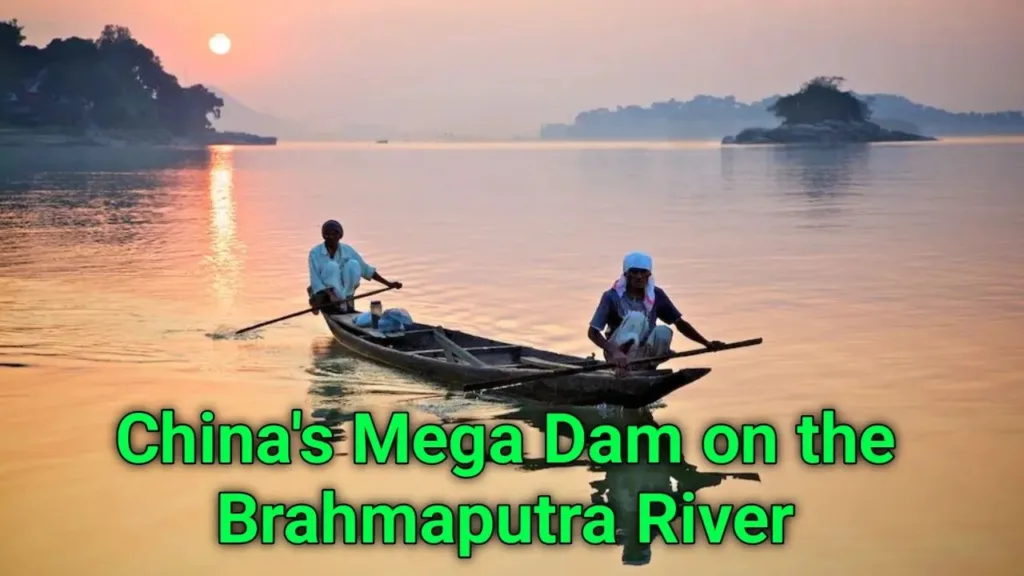
In a major geo-political development, China has officially commenced the construction of a massive dam project on the Brahmaputra River, near its border with India’s Arunachal Pradesh. Priced at a staggering USD 167.8 billion, this project has triggered widespread concern among India, Bangladesh, and environmentalists globally.
The dam, which is located in Tibet’s Nyingchi City, lies on the lower reaches of the Yarlung Tsangpo, which becomes the Brahmaputra River as it enters India. The location — near the Great Bend of the river — is strategically chosen due to a dramatic drop of 2,000 meters within a 50 km stretch, offering immense hydropower potential.
Why This Dam Has Set Alarms Ringing
China plans to develop five cascading hydropower stations, making it potentially the world’s largest infrastructure project of its kind. But the consequences for the Brahmaputra River’s natural flow could be profound — especially for countries downstream.
India and Bangladesh are downstream dependents of the Brahmaputra River. Any unilateral alteration in the river’s flow by China could severely impact agriculture, water availability, ecology, and even political stability in the region. In India, this especially affects Arunachal Pradesh and Assam, where communities are highly reliant on the Brahmaputra for farming, fisheries, and daily sustenance.
A River of Critical Importance
The Brahmaputra River is one of the major transboundary rivers in Asia. Originating in Tibet’s Chemayungdung Glacier, it flows for 1,200 km eastward as the Yarlung Tsangpo, makes a unique ‘U’ turn at Namcha Barwa, and then enters India’s Arunachal Pradesh. After meeting the Dibang and Lohit rivers, it is officially called the Brahmaputra in India.
Its flow is unique — moving west to east in Tibet, then reversing to east to west in India. This change, along with multiple rain-fed tributaries, results in flood-prone, silt-rich channels and the creation of the world’s largest river island — Majuli.
In India, the river cuts through Arunachal Pradesh, Assam, and parts of West Bengal, before entering Bangladesh as the Jamuna River and finally merging with the Padma River, emptying into the Bay of Bengal.
What India and Bangladesh Fear
The massive diversion and regulation of the Brahmaputra River by China threaten to destabilize water security for millions. Both countries fear:
- Reduced downstream flow during dry seasons
- Flash floods or artificial floods during monsoon seasons
- Impacts on agriculture, especially rice and jute production
- Biodiversity damage, especially in the Eastern Himalayas
- Political leverage by China using water as a tool in strategic conflicts
Additionally, the environmental cost of disturbing such a sensitive ecological region could be disastrous — triggering landslides, deforestation, and disruptions in wildlife corridors.
Is There a Water Sharing Agreement?
Despite the river being shared among four countries — China (50.5%), India (33.3%), Bangladesh (8.1%), and Bhutan (7.8%) — there is no binding multilateral water-sharing treaty.
India and China did sign an umbrella Memorandum of Understanding (MoU) in 2013 to cooperate on transboundary rivers. However, according to the Ministry of Jal Shakti, there’s been no recent active engagement under this MoU.
Two separate MoUs — one each for the Brahmaputra and Sutlej Rivers — were signed. But the Brahmaputra MoU lapsed in 2023 and is currently under negotiation for renewal. The Sutlej MoU, signed after the Parechu lake burst, also remains pending. The Expert Level Mechanism, which was supposed to meet annually since 2006, has seen frequent disruptions due to growing diplomatic tensions.
China’s Justification
China maintains that the dam project is part of its ambitious renewable energy goal to reduce reliance on fossil fuels. The region’s massive hydropower potential is being tapped to build a green energy grid across western China.
Chinese officials argue that no major damage will be caused to downstream nations and that run-of-the-river designs won’t severely affect water flow. However, the lack of transparency, data sharing, and unilateral planning makes it hard for India and Bangladesh to trust these claims.
Future Outlook: What Can Be Done?
India and Bangladesh must continue to press for regional cooperation on river governance. Possible measures include:
- Renewing MoUs and demanding year-round hydrological data
- Strengthening the role of SAARC or BIMSTEC to develop water treaties
- Building domestic water storage and flood control systems
- Increasing satellite monitoring of upstream Chinese projects
- Pushing for a UN-led framework on shared river governance
Without a formal treaty or confidence-building mechanism, the situation remains a high-risk geopolitical flashpoint.
FAQs About the Brahmaputra River and China’s Dam
Q1: What is the current status of China’s dam on the Brahmaputra River?
A: Construction has officially begun in Nyingchi City, Tibet, with five planned hydropower stations. It is China’s largest such project so far.
Q2: Why are India and Bangladesh worried?
A: Both countries fear changes in water flow, flood risks, and damage to agriculture and ecology due to the dam’s regulation of the Brahmaputra River.
Q3: Is there any water-sharing treaty between India and China?
A: No formal treaty exists. Only expired MoUs and limited cooperation mechanisms are in place.
Q4: What makes the Brahmaputra River so unique?
A: Its flow reverses direction between Tibet and India, carries high silt, and forms the world’s largest river island (Majuli). It is ecologically and agriculturally vital.
Q5: Can China use the dam as a ‘water weapon’?
A: While speculative, experts believe that in a conflict scenario, controlling water flow could give China strategic leverage, making it a potential water weapon.
Conclusion
The construction of a mega-dam by China on the Brahmaputra River is not just an infrastructure project; it’s a regional geopolitical concern. As the river flows across national borders and sustains millions, any disturbance at its upper reaches poses a threat downstream. The lack of binding treaties, rising distrust, and unilateral development make this situation extremely fragile. Whether this dam becomes a tool for progress or pressure remains to be seen — but for now, it has surely placed the Brahmaputra River at the center of Asian power dynamics.
